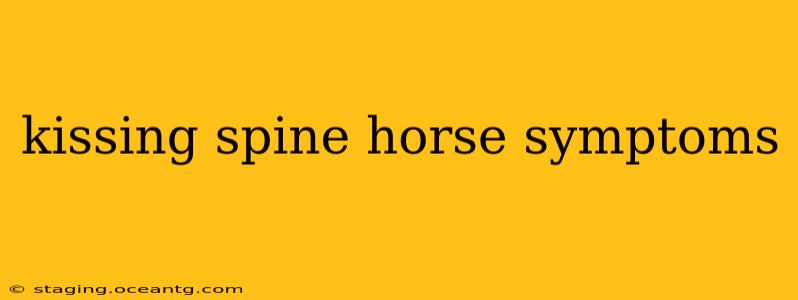Kissing spine, formally known as dorsal displacement of the spinous processes (DDSP), is a debilitating condition affecting horses. It occurs when the spinous processes of the vertebrae in the thoracic or lumbar region come into abnormally close contact, causing pain, inflammation, and restricted movement. Understanding the symptoms is crucial for early diagnosis and effective management. This comprehensive guide explores the various symptoms, offering insights for horse owners and professionals alike.
What are the common symptoms of kissing spine in horses?
The most common symptoms of kissing spine are subtle and often misinterpreted as other issues. Early detection is crucial to prevent the condition from worsening and becoming more difficult to manage. Many horses will exhibit some or all of the following symptoms:
- Difficulty with Saddling: Horses may exhibit resistance to being saddled, showing signs of discomfort when the saddle is placed or tightened.
- Changes in Temperament: A previously docile horse might become irritable, moody, or unwilling to work.
- Back Pain: This can manifest in various ways, including reluctance to be ridden or difficulty with certain movements like backing up or turning. They may also show stiffness or resistance to flexion of the back.
- Performance Issues: Horses with kissing spine often show reduced performance levels, including difficulty with jumping, collecting, or performing other complex maneuvers. They might tire more quickly than usual.
- Muscle Atrophy: Wasting of the muscles along the back and topline can be a significant symptom. This is often a result of the horse trying to compensate for the pain.
- Gait Changes: Changes in gait might include a short, choppy stride, lameness (though not always obvious), or a reluctance to engage the hindquarters.
- Sensitivity to Touch: Palpating the affected area of the spine might cause discomfort or sensitivity.
- Tail Tonus Changes: A horse might exhibit unusual tail carriage or tension, a sign of discomfort or pain in the surrounding area.
What are some less common symptoms of kissing spine?
While the symptoms mentioned above are prevalent, some horses may display less common signs, making diagnosis challenging:
- Difficulty mounting: The horse may react negatively to being mounted, displaying signs of apprehension or pain.
- Difficulty with certain types of work: Some horses may only show symptoms when performing specific tasks, like dressage movements or jumping higher obstacles.
- Chronic poor performance: This might be a gradual decline over time, often attributed to other causes before kissing spine is suspected.
How is kissing spine diagnosed in horses?
Diagnosis requires a thorough veterinary examination, often including:
- Physical Examination: A vet will carefully examine the horse's back, assessing for muscle atrophy, sensitivity to touch, and range of motion.
- Neurological Examination: To rule out other potential causes of the symptoms.
- Radiographs (X-rays): This is crucial for visualizing the spinous processes and confirming their contact.
- Ultrasound: May be used to assess soft tissue damage.
- Nuclear Scintigraphy (Bone Scan): This helps identify areas of inflammation.
- CT or MRI scans: These advanced imaging techniques can provide more detailed information about the spine's structure and any associated soft tissue damage.
Can kissing spine be treated?
Treatment options vary depending on the severity of the condition and the horse's individual response. They often involve a combination of approaches:
- Conservative Management: This may include rest, physical therapy, medication (pain relief, anti-inflammatory drugs), and targeted exercise programs.
- Surgical Intervention: In severe cases, surgery may be necessary to separate the spinous processes. Several surgical techniques exist, and the choice depends on the specific situation.
What is the prognosis for horses with kissing spine?
The prognosis for horses with kissing spine varies widely, depending on factors like the severity of the condition, the extent of associated soft tissue damage, the horse's response to treatment, and the owner's commitment to long-term management. With appropriate diagnosis and management, many horses can return to a comfortable, functional life, though complete resolution may not always be possible. Early diagnosis and consistent management are crucial to optimize the outcome.
What are some preventative measures for kissing spine?
While the exact cause of kissing spine remains unclear, some preventative measures can be taken:
- Proper training: Avoid over-training and ensure appropriate conditioning.
- Correct saddle fit: A poorly fitting saddle can exacerbate back problems.
- Regular veterinary checkups: Early detection is key.
- Appropriate exercise and conditioning: A balanced exercise program can help maintain back health.
This information is for general knowledge and does not substitute professional veterinary advice. If you suspect your horse may have kissing spine, consult with a veterinarian for proper diagnosis and treatment.
